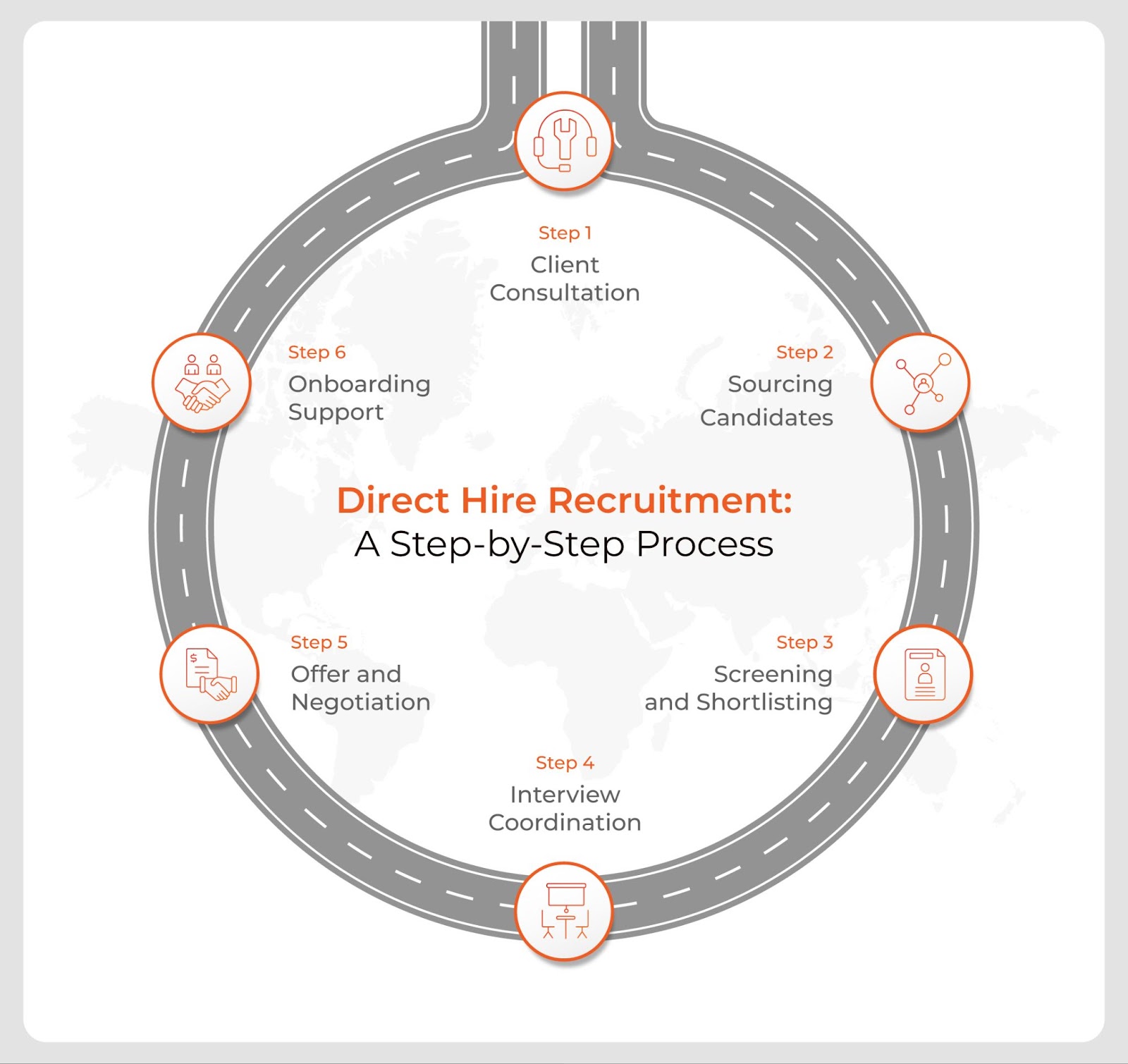Hiring for a permanent role is a high-stakes decision with lasting consequences. You’re choosing someone who’ll shape outcomes, strengthen culture, and stick around when things get tough. And when the wrong person makes it through? The fallout is immediate. Missed targets. Team friction. And worst of all, starting over.
That’s why, in direct hire recruiting, the priority is clear: get it right the first time. Speed is valuable, but only when it comes after a well-executed, precise search that brings you people who truly add value from day one.
SHRM’s 2024 Talent Trends Report says it loud: over 75% of organizations struggled to fill full-time roles last year. Low application volumes. Mismatched expectations. Endless back-and-forth. Sound familiar?
It doesn’t have to be this hard. With a structured direct hire recruiting process, you build teams that last, reduce the painful churn, and maybe even stop worrying about open positions.
Here’s how the process actually works and why having a staffing partner like SPECTRAFORCE by your side can bring clarity and consistency to every step.

Step 1: Client Consultation
The first step in direct hire recruitment is gaining a clear, detailed understanding of the role and hiring needs, and that happens through an in-depth consultation between the recruiter and the client.
No templated job descriptions and vague requirements, but a strategic discussion between the client and the recruiting partner to map:
- The role’s business impact
- Required technical and soft skills
- Cultural fit parameters
- Compensation benchmarks
- Urgency, hiring timelines, and reporting structure
Apart from collecting inputs, this step is about aligning hiring goals with broader workforce strategy.
Step 2: Sourcing Candidates
Once the brief is locked, the search begins. This is where direct hire recruiting takes a more targeted and strategic approach compared to traditional job postings and inbound applications.
Staffing partners tap into passive talent pools, industry-specific communities, referral networks, and AI-powered sourcing engines. With a permanent role on offer, sourcing is more targeted, often drawing candidates who are employed but open to the right opportunity.
That’s where we can make a difference. We combine advanced talent mapping with deep industry networks to identify the right candidates. The goal is to find people who align with your business goals and are ready to make a meaningful move.
Step 3: Screening and Shortlisting
Next comes the most critical step: screening. The screening phase is designed to validate not just the resume, but the fit for the job.
Agencies assess the fit by conducting:
- Behavioral and situational interviews
- Skill-based assessments (where applicable)
- Motivation and alignment checks
- Cultural and value fit analysis
Apart from the requisite credentials, every shortlisted candidate is presented with detailed insights and context. This saves internal TA teams time and significantly improves candidate quality at the top of the funnel.
By the time profiles reach the hiring manager’s desk, they’re not just potential fits, but high-probability hires.
Step 4: Interview Coordination
Even the strongest candidates can drop off if the process is clunky. That’s why coordination is treated as a strategic step.
Recruiters manage the scheduling, prep candidates for each stage, and communicate expectations. They also coach hiring managers to ensure alignment in feedback and structure.
When working with a staffing partner, you get more interviews, and more of them will be with the right people. Every interaction is optimized to minimize delays, avoid miscommunication, and keep top talent engaged.
Also read: Interview Red Flags for Employers and Candidates: What to Look Out For
Step 5: Offer and Negotiation
At this stage, the candidate is a qualified lead and genuinely interested in the role. Now comes the crucial phase of offer and negotiation. Many internal teams lose strong candidates here. Delays, unclear communication, or uncompetitive offers often turn promising prospects into missed opportunities.
A staffing partner helps structure offers that are both competitive and aligned with market conditions, within the budget set out by the client. They manage expectations on both ends and navigate negotiations in real time. That includes:
- Compensation benchmarking
- Notice period and relocation considerations
- Counter-offer management
- Start-date alignment
This step essentially entails making an offer and closing the right candidate with clarity, confidence, and speed.
Step 6: Onboarding Support
Direct hire recruitment doesn’t end at offer acceptance. Onboarding is a key opportunity to reinforce the employer brand.
Agencies often assist with:
- Pre-boarding check-ins and communication
- Documentation coordination
- First-day readiness
- Feedback collection post-joining
Direct hire staffing agencies like SPECTRAFORCE support clients with onboarding touchpoints that reduce early attrition risk and ensure a smooth transition into the role. Because long-term success doesn’t start on Day 1—it starts before it.
Learn more about aspects of direct hiring in our ultimate guide here.
Why the Process Matters More Than Ever
With longer time-to-hire metrics and increased candidate expectations, unplanned or reactive hiring no longer suffices. A structured direct hire recruiting process minimizes missteps, accelerates outcomes, and improves candidate experience across the board.
Conclusion: Direct Hire is About Building, Not Just Hiring
If your goal is to scale sustainably, hiring right matters more than hiring fast. Direct hire staffing offers a deliberate, structured approach that reduces churn, improves retention, and strengthens team foundations.
But here’s what many overlook: the process only works when it’s executed with precision. From intake to onboarding, every step needs clarity, consistency, and candidate care.
Partnering with a staffing expert like SPECTRAFORCE doesn’t just give you resumes. It gives you strategic recruitment intelligence built to match your goals, not just your open reqs.
Ready to streamline your hiring process?
Contact us today to start your direct hire recruiting journey and secure long-term talent the right way.
FAQs
What are the benefits of direct hire recruiting for employers?
It improves retention, reduces time-to-productivity, and enhances long-term culture fit. It also attracts higher-caliber candidates looking for permanent roles.
How long does the direct hire staffing process take?
Typically 2–6 weeks, depending on the complexity of the role and availability of talent. Agencies often shorten this timeline through pre-qualified pipelines.
Is direct hire recruiting more expensive than other staffing solutions?
Direct hire staffing involves an upfront investment but often saves costs long-term by reducing turnover and repeat hiring cycles.
How does a staffing agency support the direct hire staffing process?
From intake to onboarding, staffing partners manage sourcing, screening, coordination, negotiation, and follow-up, ensuring a seamless experience on both ends.
Can direct hire recruiting help with hard-to-fill positions?
Yes. Staffing agencies use targeted sourcing strategies and passive candidate engagement to fill niche, specialized, or leadership roles effectively.



